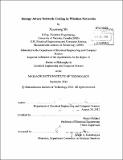| dc.contributor.advisor | Muriel Médard. | en_US |
| dc.contributor.author | Shi, Xiaomeng, Ph. D. Massachusetts Institute of Technology | en_US |
| dc.contributor.other | Massachusetts Institute of Technology. Department of Electrical Engineering and Computer Science. | en_US |
| dc.date.accessioned | 2013-04-12T19:36:57Z | |
| dc.date.available | 2013-04-12T19:36:57Z | |
| dc.date.copyright | 2012 | en_US |
| dc.date.issued | 2012 | en_US |
| dc.identifier.uri | http://hdl.handle.net/1721.1/78533 | |
| dc.description | Thesis (Ph. D.)--Massachusetts Institute of Technology, Dept. of Electrical Engineering and Computer Science, 2012. | en_US |
| dc.description | Cataloged from PDF version of thesis. | en_US |
| dc.description | Includes bibliographical references (p. 97-104). | en_US |
| dc.description.abstract | Energy is one of the most important considerations in designing reliable low-power wireless communication networks. We focus on the problem of energy aware network coding. In particular, we investigate practical energy efficient network code design for wireless body area networks (WBAN). We first consider converge-cast in a star-shaped topology, in which a central base station (BS), or hub, manages and communicates directly with a set of nodes. We then consider a wireless-relay channel, in which a relay node assists in the transmission of data from a source to a destination. This wireless relay channel can be seen as a simplified extended star network, where nodes have relay capabilities. The objective is to investigate the use of network coding in these scenarios, with the goal of achieving reliability under low-energy and lower-power constraints. More specifically, in a star network, we propose a simple network layer protocol, study the mean energy to complete uploads of given packets from the nodes to the BS using a Markov chain model, and show through numerical examples that when reception energy is taken into account, the incorporation of network coding offers reductions in energy use. The amount of achievable gains depends on the number of nodes in the network, the degree of asymmetry in channel conditions experienced by different nodes, and the relative difference between transmitting and receiving power at the nodes. We also demonstrate the compatibility of the proposed scheme with the IEEE 802.15.6 WBAN standard by describing ways of incorporating network coding into systems compliant to the standard. For a wireless relay channel, we explore the strategic use of network coding according to both throughput and energy metrics. In the relay channel, a single source communicates to a single sink through the aid of a half-duplex relay. The fluid flow model is used to describe the case where both the source and the relay are coding, and Markov chain models are proposed to describe packet evolution if only the source or only the relay is coding. Although we do not attempt to explicitly categorize the optimal network coding strategies in the relay channel under different system parameters, we provide a framework for deciding whether and where to code, taking into account of throughput maximization and energy depletion constraints. | en_US |
| dc.description.statementofresponsibility | by Xiaomeng Shi. | en_US |
| dc.format.extent | 104 p. | en_US |
| dc.language.iso | eng | en_US |
| dc.publisher | Massachusetts Institute of Technology | en_US |
| dc.rights | M.I.T. theses are protected by
copyright. They may be viewed from this source for any purpose, but
reproduction or distribution in any format is prohibited without written
permission. See provided URL for inquiries about permission. | en_US |
| dc.rights.uri | http://dspace.mit.edu/handle/1721.1/7582 | en_US |
| dc.subject | Electrical Engineering and Computer Science. | en_US |
| dc.title | Energy aware network coding in wireless networks | en_US |
| dc.type | Thesis | en_US |
| dc.description.degree | Ph.D. | en_US |
| dc.contributor.department | Massachusetts Institute of Technology. Department of Electrical Engineering and Computer Science | |
| dc.identifier.oclc | 832740002 | en_US |
